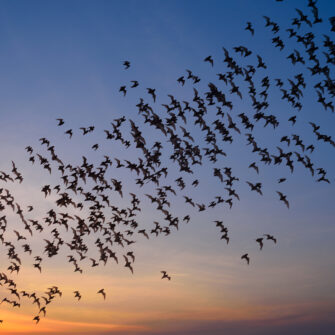
Bat Migration
Did you know Nevada is home to 23 different species of bats?
Nevada, a state known for its diverse landscapes and unique ecosystem, is home to many different wildlife, including bats. Bats can live in caves, old mines, trees, bridges, abandoned buildings, attics, and other similar environments. These flying mammals play an important role in pest control, pollinating plants and dispersing seeds. Bats are helpful because they eat a lot of insects including mosquitoes, beetles, moths, grasshoppers, and locusts, which helps to save money in crop damage and pesticide costs in the United States each year. Many of these insects are harmful to crops, forests and humans. Also, bat poop (known as guano) can be used to make fertilizer, gun powder, and antibiotics. However, bats can carry many different diseases such as salmonellosis, yersiniosis, histoplasmosis, and rabies.
Bats try to avoid contact with humans and other animals that can hurt them. They usually only bite if they are scared or are trying to defend themselves. If you find yourself in any of the situations below, please seek the appropriate help recommended to protect you and your family:
- If you, or your pet, are bitten by a bat, call your local health authority to report the incident and see your doctor or vet immediately.
- If you find a bat in your home or see a sick or injured bat, call Nevada Department of Wildlife at 775-688-1500 for it to be safely contained, do not try to catch it yourself. All bats found in your home and all sick and injured bats should be sent to the Nevada Department of Agriculture for rabies testing, call 775-353-3709 for more information.
Some bats, including the Mexican Free-Tailed bat, migrate for the winter meaning they will leave Nevada when it starts to get cold and move to a warmer area. As the weather starts to get colder and bats begin to migrate, we may see them more around our homes and in the environment. If you don’t want bats roosting (sitting or resting) in or around your house this is a good time to bat proof your home.
For steps or plans on how to bat proof your home (also known as exclusion plans), please visit Bat Conservation International or Nevada Department of Wildlife.
McCarran Boulevard Bridge in Nevada
Have you heard of the McCarran Boulevard Bridge in Sparks, Nevada housing over 40,000 bats? Hiding underneath the bridge are thousands of bats roosting and making this spot their home. During the day, you would barely know that bats lived there. However, when the sun begins to set, thousands of bats fly out from under the bridge to find their dinner (insects). This is an amazing site to see and many families, school classes, and individuals will come out to see these bats fly though the air. Make sure to stop by the bridge before colder weather approaches and the bats begin to migrate to warmer places.
If you plan to visit the bats under McCarran Boulevard Bridge, make sure you know how to keep yourself and the bats healthy. Since bats carry diseases such as rabies, it is important that you never touch a bat, try to feed a bat, or touch feces (poop) from a bat. If you happen to be bitten by a bat, make sure you see your doctor immediately. For more information on bats and how to protect yourself from diseases spread between humans and bats, click here.
For more information and resources about bats:
- NDOW Publications – Nevada Wildlife
- bat_brochure17x22 (ndow.org)
- McCarran Boulevard Bridge In Nevada Is Home To A Bat Colony (onlyinyourstate.com)